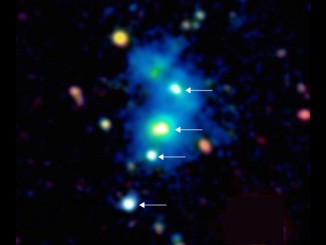
Quasars are the most luminous objects in the universe, beacons that shine across vast cosmological distances. They are galaxies that have particularly active supermassive black holes at their cores, objects surrounded by discs of extremely hot matter spiralling into oblivion and emitting bright beams of particles along their spin axes at nearly the speed of light.
A European research team using new observations from the European Southern Observatory’s Very Large Telescope (VLT) in Chile has found that the rotation axes of the central supermassive black holes in a sample of quasars are parallel to each other over distances of billions of light-years. The team has also found that the rotation axes of these quasars tend to be aligned with vast structures in the cosmic web in which they reside.
“The first odd thing we noticed was that some of the quasars’ rotation axes were aligned with each other – despite the fact that these quasars are separated by billions of light-years,” said team leader Damien Hutsemékers from the University of Liège in Belgium.
The team used the FORS instrument on the VLT to study 93 quasars that were known to form huge groupings spread over billions of light-years, seen at a time when the universe was about one third of its current age.
When astronomers look at the distribution of galaxies at scales of billions of light-years they find that they are not evenly distributed, but form a cosmic web of filaments and clumps surrounding huge voids where galaxies are scarce. This is known as large-scale structure.
These VLT results indicate that the rotation axes of the quasars tend to be parallel to the large-scale structures in which they reside, so if the quasars are in a long filament then the spins of the central black holes will point along the filament. The researchers estimate the probability that these alignments are due to chance is less than 1%.
“A correlation between the orientation of quasars and the structure they belong to is an important prediction of numerical models of evolution of our universe. Our data provide the first observational confirmation of this effect, on scales much larger that what had been observed to date for normal galaxies,” adds Dominique Sluse of the Argelander-Institut für Astronomie in Bonn, Germany, and University of Liège.
The team could not see the rotation axes or the jets of the quasars directly. Instead, they measured the polarisation of the light from each quasar and found a significantly polarised signal for 19 of them. The polarisation direction in combination with other information can be used to deduce the angle of the accretion disc and hence the direction of the quasar’s spin axis.
“The alignments in the new data, on scales even bigger than current predictions from simulations, may be a hint that there is a missing ingredient in our current models of the cosmos,” concludes Dominique Sluse.
Further information:
http://www.eso.org/public/about-eso/



